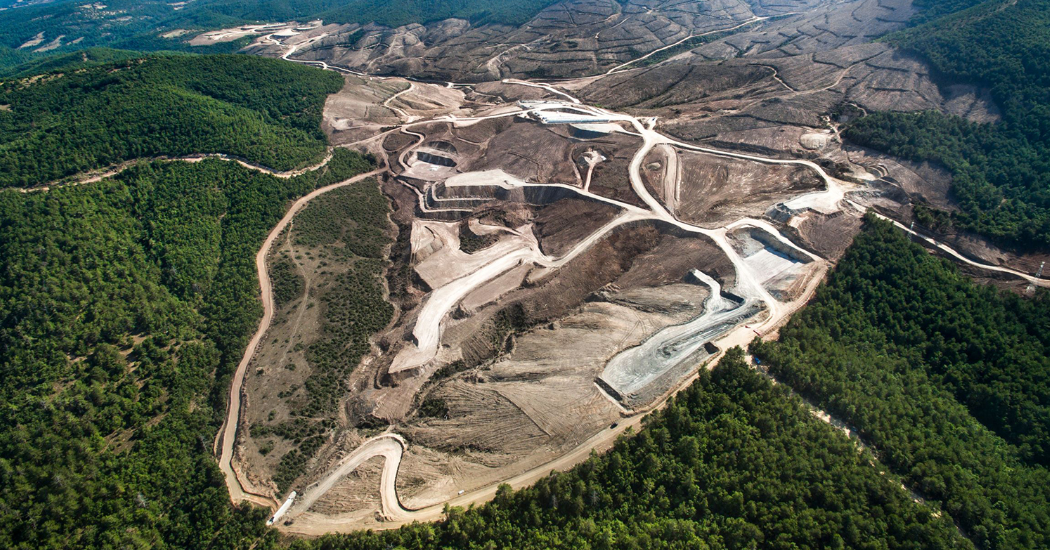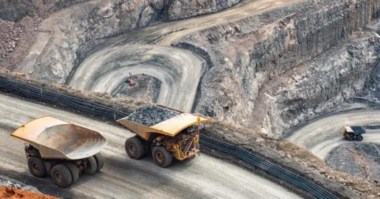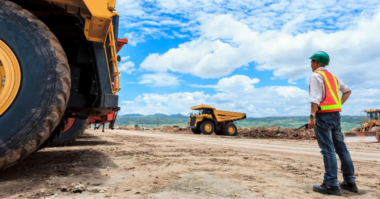The mining, quarrying and construction industries present some of the most challenging applications encountered by pumps. The range of process fluids handled varies quite significantly across these processes, ranging from clear water to heavy slurries and from alkaline, pH neutral to highly corrosive fluids. As well as having to deal with the process requirements, products must also be compliant with the environmental and legislative constraints in play across geographies. Harvinder Bhabra from Sulzer discusses how the variation in process fluid types can determine the pump and materials designs.
Water, chemicals and slurry
Whilst the mining, quarrying and construction industries may seem quite far removed from each other, there are several similarities in the process fluids handled across all three industries. All incorporate an element of product extraction, followed by transfer through the various parts of the processes before handling the disposal and treatment of waste thereof. One way to distinguish between the various pump designs utilized is to segregate the fluids into process “streams”. In simplified terms these are:
- Slurry – fluids (normally water) carrying medium to large solids. When the carrier fluid also has corrosive properties, the criteria for materials selection is also affected
- Dirty water – fluids carrying small amounts of fine solids
- Process water – clear fluid
- Other process fluids – often with various degrees of corrosive properties
The pump types for each of these streams may vary by hydraulic design and/or materials of construction. Sulzer’s world class range of pumps and materials offer a broad range of solutions for these challenging applications.
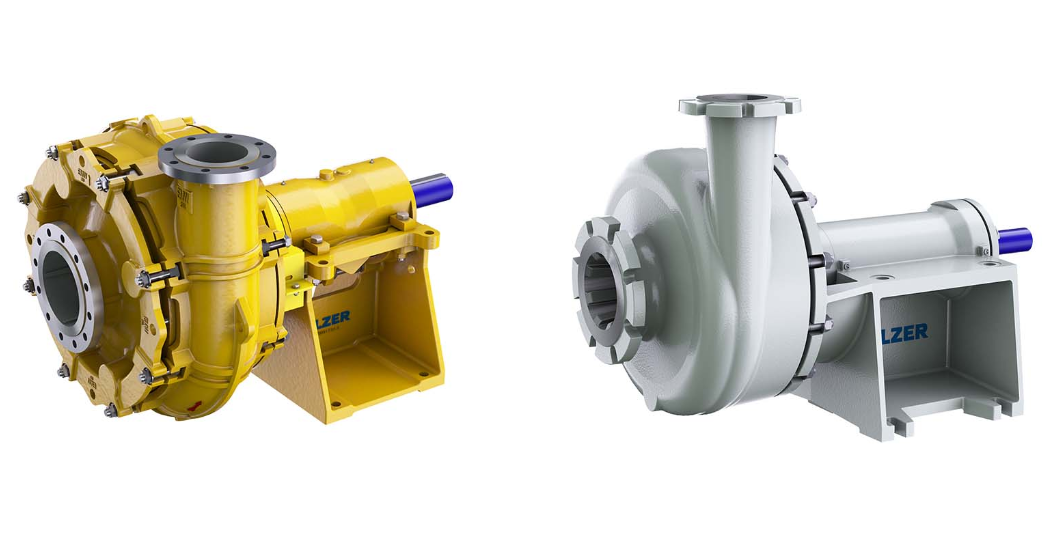
EMW heavy-duty slurry pump and PLT slurry pump.
Mining and metals processing
Fluids in mining and metals processing go through several stages. Whilst there are some variations in this depending on the final product, the most common sequence involves ore extraction, comminution, separation and thickening followed by the transport of the desired product to the refining and finishing process, whilst the waste has to be safely disposed of.
Extraction – To ensure safe mining, residual or incoming ground water must be removed continuously. Water ingress may come from a high water table as well as from rainfall, localized flooding or snow melt. Deeper mines may also be affected by subterranean waterways or pockets of water in the ore body. Dewatering fluids are defined as being contaminated with < 50 g/l of fine solid particulates which may be abrasive, and the carrier fluid may also have some corrosive properties due to ground conditions. Fluids with a solids content above this are classified as slurry, with the classification dependent on size, concentration, density, and hardness of the solids.
Comminution – the ore starts off as large rocks and undergoes a series of steps to reduce its size so that the desired metal may be separated from the rock. The initial crushing and screening are dry processes and water is not added into the process until the ore gets to the grinding mills. Here the particle size becomes small enough to liberate the commodity from the rock through a separation process before it is finally thickened for the refining and finishing process. Methods for separation depend on the ore type, e.g. screening, gravity, dense medium, magnetic or flotation, resulting in the desired product in the form of a concentrate. The waste generated from the process forms the largest volume, and this then must be disposed of safely.
The concentrate goes for refining and finishing, where the processes contain corrosive fluids, adding another dimension to the equipment design requirements. Erosion wear becomes less significant, and corrosion becomes the bigger challenge.
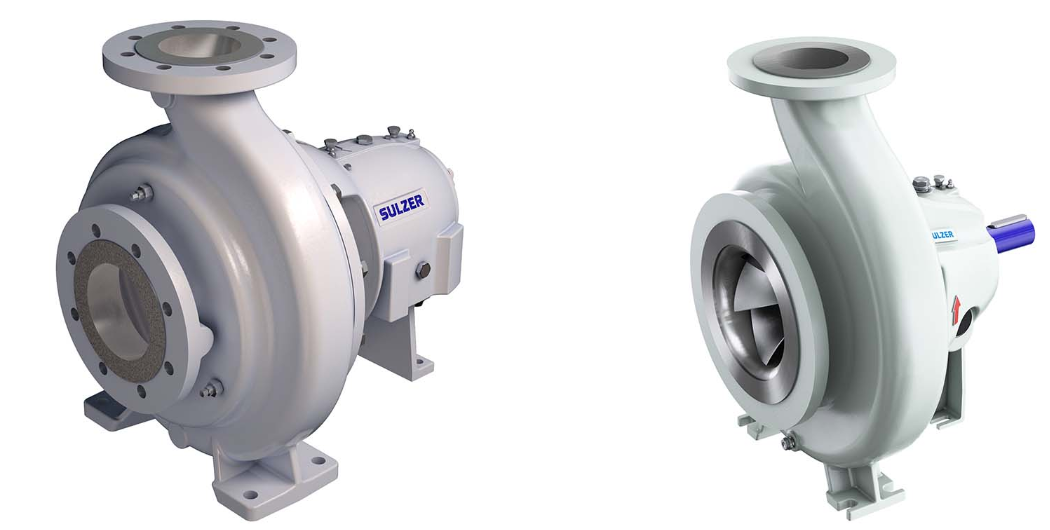
AHLSTAR pump and SNS process pump.
Quarrying
Quarry pits are essentially smaller open cast mines, and the requirements for dewatering the working areas are very similar to those in mining. The product being extracted may be inert, e.g. sand, rock, gravel, etc., or containing minerals such as kaolin. With mineral quarrying, the key difference from mining is that here the product is often extracted by hydro-mining and the resultant slurry pumped out of the pit for further processing. One of the consequences of this is that stones and rocks can also find their way into pumping equipment, and the hydraulic and material design must allow for this. Pumps with large passage passing capability are required, often mounted inside the quarry pit, operating on a suction lift. Deeper quarries require correctly configured in-line booster pumps or intermediate pump stations.
This subsequent processing of the product is generally done close to the quarry pit, and a range of slurry and water handling pumps will be utilized within the plant.
Tunneling
Major tunneling projects involve the movement of large volumes of rock and soil as well as water. The selection, operation and maintenance of pumps and related equipment can therefore have a significant impact on costs and schedule compliance. Water management involves removal of excess water as well as process water feed for machinery operation, dust suppression, etc.
Initially, the construction site may need to be stabilized to prevent flooding of the work area, involving proactive as well as reactive dewatering. The amount of water that needs handling can vary significantly depending on the site location, and seasonal conditions can also cause a need to increase or decrease dewatering activities. Tunnel boring machines and drilling equipment require a reliable supply of cooling water, which, once utilized, must be recovered, extracted, and treated.
Cuttings are also slurrified for removal and this may require pumps designed for high wear and large solids handling capability.
Factors affecting design and material selection for pumps in mining, quarrying, and tunneling
Slurry pumps
The majority of slurry pumps are centrifugal end suction or vertical shaft pumps. Key features are abrasion resistance through suitable materials, large clearances, large-diameter impellers for low operating speed to reduce wear, high hydraulic efficiency, and ease of maintenance.
In long-distance pumping applications, high-pressure pumps are required to allow staged pumping.
Froth pumps
Froth pumps need to deal with artificially increased flow rates due to the presence of air and must be self-venting design to prevent air locking. Conventional horizontal slurry pumps can be adapted for this or vertical shaft pumps with integral tanks designed to allow air venting.
Gravel pumps
Gravel and dredge pumps are also types of slurry pumps and have much larger gaps between the impeller shrouds to enable large solids handling and have low NPSH characteristics as they often operate under suction lift conditions
Process water pumps
These are usually ISO/DIN/ANSI standard end suction pumps designed for high hydraulic efficiency and reliable operation.
Chemical process pumps
Standard ISO/DIN/ANSI end suction pumps designed for high hydraulic efficiency with a variety of material options to handle various chemicals within the process.
Dewatering
Several technologies may be used in dewatering applications, and the pumps can be of fixed or mobile installations. Mobile installations normally use submersible or self-prime skid-mounted pumps, whereas fixed installations can have horizontal end suction, multi-stage, or vertical shaft centrifugal or turbine pumps.
Sulzer is a global pump manufacturer with a strong engineering heritage and a comprehensive worldwide service network supporting our new equipment and supplying parts on a local level. Our customers benefit from increased service intervals and exceptional reliability, supported by our wireless condition monitoring system. Optimized designs and reduced energy consumption deliver low operational costs and help to lower carbon footprints. Furthermore, our extensive knowledge of customer processes ensures delivery of optimal, energy-efficient equipment and solutions.
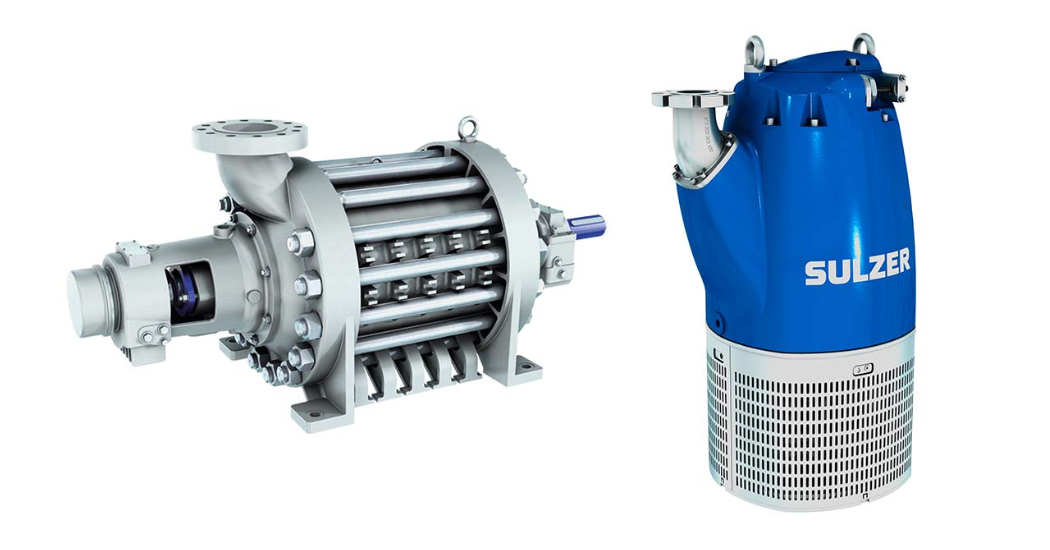
HPH mine dewatering pump and submersible drainage pump XJ 900.
Materials technology
For abrasive slurry applications, white iron alloys and elastomeric materials are used. Where the carrier or process fluid in a slurry application is corrosive, a fine balance between erosive and corrosive wear is sought to find the optimal performance. Material selection is determined by a thorough analysis of the solids being handled, and material toughness may also need to be considered where large solids are encountered.
The majority of chemical process pumps are of metallic designs in various stainless steels, duplex or super duplex alloys to suit the application. In some instances, non-metallic pumps may also be used where a metallic construction does not provide the required performance. Water pumps are more straightforward, with cast iron or stainless-steel alloys being most commonly used.
Sulzer offers a comprehensive portfolio of innovative pumps and agitators for mining, minerals, and metals processing, from slurry to clear liquid. Our equipment is tailor-made for challenging process conditions that include corrosive and abrasive liquids. A deep understanding of these applications, which involve handling harsh fluids, allows us to propose solutions that meet customer requirements.
Sulzer is a global pump manufacturer with a strong engineering heritage and a comprehensive worldwide service network supporting our new equipment and supplying parts on a local level. Our customers benefit from increased service intervals and exceptional reliability, supported by our wireless condition monitoring system. Optimized designs and reduced energy consumption deliver low operational costs and help to lower carbon footprints. Furthermore, our extensive knowledge of customer processes ensures delivery of optimal, energy-efficient equipment and solutions.
About Sulzer
Sulzer is a global leader in fluid engineering. We specialize in pumping, agitation, mixing and separation technologies for fluids of all types. Our customers benefit from our commitment to innovation, performance and quality and from our responsive network of 180 world-class production facilities and service centers across the globe. Sulzer has been headquartered in Winterthur, Switzerland, since 1834. In 2020, our 15’000 employees delivered revenues of CHF 3.3 billion. Our shares are traded on the SIX Swiss Exchange (SIX: SUN). The Flow Equipment division specializes in pumping solutions specifically engineered for the processes of our customers. We provide pumps, agitators, compressors, grinders and screens developed through intensive research and development in fluid dynamics and advanced materials. We are a market leader in pumping solutions for water, oil and gas, power, chemicals and most industrial segments.

